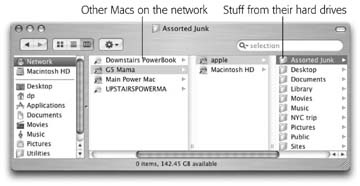Accessing Other Macs on Your Network
At last! Now that all your Macs are configured to share their goodies, and you've set up any accounts you need, you can finally get this show on the road and actually connect with another Mac on your network (Figure 6-9).
The connection method you choose depends on which version of the Mac OS you're using. Even within the same operating system, there are different connection methods that give you and your network mates a variety of ways to access each other's machines. In this section, you'll learn about different ways to connect to other Macs and discover what you can do once you've hooked up with another Mac.
Getting Around from an OS X Mac
If you're running Mac OS X, you have it made as far as connectivity goes. Apple engineers have given you the ability to connect to pretty much any other computer—regardless of its operating system—with ease. There are a couple of methods by which you can do this. First, in Mac OS X 10.3 and later, you can use the Sidebar, a simple yet powerful tool for networking wizards such as yourself. Second, in all versions of Mac OS X, the Connect to Server option is available. You get to see both of them in action below.

Figure 6-9. The point of file sharing is to bring other Macs and PCs onto your own screen—in this example, the contents of the account called apple on the Mac called G5 Mama. By dragging icons back and ...
Get Home Networking: The Missing Manual now with the O’Reilly learning platform.
O’Reilly members experience books, live events, courses curated by job role, and more from O’Reilly and nearly 200 top publishers.

